PMC/PubMed Indexed Articles
Indexed In
- Genamics JournalSeek
- RefSeek
- Hamdard University
- EBSCO A-Z
- OCLC- WorldCat
- Publons
- Geneva Foundation for Medical Education and Research
- Euro Pub
- Google Scholar
Useful Links
Share This Page
Journal Flyer

Open Access Journals
- Agri and Aquaculture
- Biochemistry
- Bioinformatics & Systems Biology
- Business & Management
- Chemistry
- Clinical Sciences
- Engineering
- Food & Nutrition
- General Science
- Genetics & Molecular Biology
- Immunology & Microbiology
- Medical Sciences
- Neuroscience & Psychology
- Nursing & Health Care
- Pharmaceutical Sciences
Abstract
High Dose Octreotide for the Treatment of Chylothorax in Three Neonates
Makoto Saito, Tomohiro Kamoda, Daigo Kajikawa, Yayoi Miyazono, Yu Kanai, Satoshi Fujiyama, Ryoko Suzuki, Miho Takahashi- Igari, Yasuhisa Urita, Ryo Sumazaki
Chylothorax is an abnormal condition of lymphatic fluid collection in the pleural space, and the somatostatin analog octreotide is thought to have a beneficial effect on chylothorax. However, the octreotide dosage and administration route for chylothorax have been inconsistent to date. We report three neonatal cases of persistent chylothorax successfully treated with high-dose octreotide infusion therapy (20 μg/kg/h). Case 1 was congenital chylothorax, Case 2 was secondary chylothorax after an operation for congenital diaphragmatic hernia, and Case 3 was chylothorax after a cardiac operation. In all cases, the chylothorax was not decreased by a low-dose octreotide infusion, but after a high-dose octreotide infusion, the chylothorax decreased and eventually vanished, with no side effects.
Conclusion: We suggest that the dose of octreotide in neonatal chylothorax can be safely increased to a maximum of 20 µg/kg/h.

